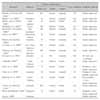Abstract
Objective
To develop a mixed dentition analysis method in consideration of the normal variation of tooth sizes.
Methods
According to the tooth-size of the maxillary central incisor, maxillary 1st molar, mandibular central incisor, mandibular lateral incisor, and mandibular 1st molar, 307 normal occlusion subjects were clustered into the smaller and larger tooth-size groups. Multiple regression analyses were then performed to predict the sizes of the canine and premolars for the 2 groups and both genders separately. For a cross validation dataset, 504 malocclusion patients were assigned into the 2 groups. Then multiple regression equations were applied.
Results
Our results show that the maximum errors of the predicted space for the canine, 1st and 2nd premolars were 0.71 and 0.82 mm residual standard deviation for the normal occlusion and malocclusion groups, respectively. For malocclusion patients, the prediction errors did not imply a statistically significant difference depending on the types of malocclusion nor the types of tooth-size groups. The frequency of prediction error more than 1 mm and 2 mm were 17.3% and 1.8%, respectively. The overall prediction accuracy was dramatically improved in this study compared to that of previous studies.
Figures and Tables
Table 2
Classification function coefficients which are used to cluster and then reassign the subjects to 2 groups (smaller vs. larger group)

Table 3
Multiple regression coefficients to predict the sum of canine, 1st premolar, and 2nd premolar sizes

References
1. Moyers RE. Handbook of orthodontics. 1988. 4th ed. Chicago: Year Book;235–240.
2. Tanaka MM, Johnston LE. The prediction of the size of unerupted canines and premolars in a contemporary orthodontic population. J Am Dent Assoc. 1974. 88:798–801.

3. Hixon EH, Oldfather RE. Estimation of the sizes of unerupted canines and premolar teeth. Angle Orthod. 1958. 28:236–240.
4. Zilberman Y, Koyoumdjisky-Kaye E, Vardimon A. Estimation of mesiodistal width of permanent canines and premolars in early mixed dentition. J Dent Res. 1977. 56:911–915.

5. Staley RN, Shelly TH, Martin JF. Prediction of lower canine and premolar widths in the mixed dentition. Am J Orthod. 1979. 76:300–309.

6. Staley RN, O'Gorman TW, Hoag JF, Shelly TH. Prediction of the widths of unerupted canines and premolars. J Am Dent Assoc. 1984. 108:185–190.

7. de Paula S, Almeida MA, Lee PC. Prediction of mesiodistal diameter of unerupted lower canines and premolars using 45 degrees cephalometric radiography. Am J Orthod Dentofacial Orthop. 1995. 107:309–314.

8. Altherr ER, Koroluk LD, Phillips C. Influence of sex and ethnic tooth-size differences on mixed-dentition space analysis. Am J Orthod Dentofacial Orthop. 2007. 132:332–339.

9. Bernabé E, Flores-Mir C. Appraising number and clinical significance of regression equations to predict unerupted canines and premolars. Am J Orthod Dentofacial Orthop. 2004. 126:228–230.

10. Diagne F, Diop-Ba K, Ngom PI, Mbow K. Mixed dentition analysis in a Senegalese population: elaboration of prediction tables. Am J Orthod Dentofacial Orthop. 2003. 124:178–183.

11. Hashim HA, Al-Shalan TA. Prediction of the size of un-erupted permanent cuspids and bicuspids in a Saudi sample: a pilot study. J Contemp Dent Pract. 2003. 4:40–53.

12. Nourallah AW, Gesch D, Khordaji MN, Splieth C. New regression equations for predicting the size of unerupted canines and premolars in a contemporary population. Angle Orthod. 2002. 72:216–221.
13. Jaroontham J, Godfrey K. Mixed dentition space analysis in a Thai population. Eur J Orthod. 2000. 22:127–134.

14. Yuen KK, Tang EL, So LL. Mixed dentition analysis for Hong Kong Chinese. Angle Orthod. 1998. 68:21–28.
15. Bishara SE, Jakobsen JR. Comparison of two nonradiographic methods of predicting permanent tooth size in the mixed dentition. Am J Orthod Dentofacial Orthop. 1998. 114:573–576.

16. Lee-Chan S, Jacobson BN, Chwa KH, Jacobson RS. Mixed dentition analysis for Asian-Americans. Am J Orthod Dentofacial Orthop. 1998. 113:293–299.

17. Schirmer UR, Wiltshire WA. Orthodontic probability tables for black patients of African descent: mixed dentition analysis. Am J Orthod Dentofacial Orthop. 1997. 112:545–551.

18. al-Khadra BH. Prediction of the size of unerupted canines and premolars in a Saudi Arab population. Am J Orthod Dentofacial Orthop. 1993. 104:369–372.

19. Lee SJ, Ahn SJ, Kim TW. Clinical crown angulation and inclination of normal occlusion in a large Korean sample. Korean J Orthod. 2005. 35:331–340.
20. Lee SJ, Moon SC, Kim TW, Nahm DS, Chang YI. Tooth size and arch parameters of normal occlusion in a large Korean sample. Korean J Orthod. 2004. 34:473–480.
21. Kim JY, Lee SJ, Kim TW, Nahm DS, Chang YI. Classification of the skeletal variation in normal occlusion. Angle Orthod. 2005. 75:311–319.
22. Lee SJ, Lee S, Lim J, Ahn SJ, Kim TW. Cluster analysis of tooth size in subjects with normal occlusion. Am J Orthod Dentofacial Orthop. 2007. 132:796–800.

23. Lee SJ, Kim TW, Suhr CH. Study of recognition of malocclusion and orthodontic treatments. Korean J Orthod. 1994. 24:193–198.
24. Im DH, Kim TW, Nahm DS, Chang YI. Current trends in orthodontic patients in Seoul National University Dental Hospital. Korean J Orthod. 2003. 33:63–72.
25. Kim SJ, Park SY, Woo HH, Park EJ, Kim YH, Lee SJ, et al. A study on the limit of orthodontic treatment. Korean J Orthod. 2004. 34:165–175.




 PDF
PDF ePub
ePub Citation
Citation Print
Print




 XML Download
XML Download